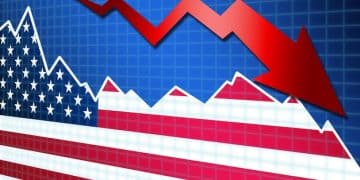Treasury Yields Hit 3.8%: Experts Predict Market Impact

Treasury yields have risen to 3.8%, prompting expert analysis of the potential effects on investments, the economy, and the Federal Reserve’s policy decisions in the United States.
The recent surge in treasury yields rise to 3.8%: expert predictions and investment implications has sent ripples through the financial markets. Investors, economists, and policymakers are closely watching how this shift will impact various sectors of the economy and the investment landscape.
Understanding Treasury Yields
Treasury yields represent the return an investor receives from holding U.S. government debt. These yields are influenced by various factors, including inflation expectations, economic growth forecasts, and the Federal Reserve’s monetary policy. A rising yield can indicate a strengthening economy or increased concerns about inflation, while a falling yield may suggest economic uncertainty or deflationary pressures.
What are Treasury Securities?
Treasury securities are debt instruments issued by the U.S. Department of the Treasury to finance government spending. These securities are considered among the safest investments globally, as they are backed by the full faith and credit of the U.S. government.
- Treasury Bills: Short-term securities maturing in one year or less.
- Treasury Notes: Intermediate-term securities maturing in two to ten years.
- Treasury Bonds: Long-term securities maturing in more than ten years.
- Treasury Inflation-Protected Securities (TIPS): Indexed to inflation to protect investors from inflationary risks.
Treasury yields serve as a benchmark for other interest rates in the economy, influencing borrowing costs for consumers and businesses, mortgage rates, and corporate bond yields. Understanding the dynamics of treasury yields is crucial for making informed investment decisions and assessing the overall health of the financial system.
Factors Driving the Increase to 3.8%
Several factors can contribute to the recent increase in treasury yields to 3.8%. These include stronger-than-expected economic data, rising inflation expectations, and changes in the Federal Reserve’s monetary policy stance. Analyzing these drivers is essential to understanding the potential trajectory of yields and their implications for the economy.
Economic Data and Growth Expectations
Positive economic data releases, such as strong employment figures, rising consumer spending, and increasing business investment, can signal a strengthening economy. This can lead to higher treasury yields as investors anticipate increased borrowing and potential inflationary pressures.

Inflation Expectations and Concerns
Rising inflation expectations also play a significant role in pushing treasury yields higher. If investors anticipate that inflation will increase in the future, they demand higher yields to compensate for the erosion of purchasing power. Inflation concerns can stem from various factors, including supply chain disruptions, increased government spending, and rising commodity prices.
- Supply Chain Disruptions: Bottlenecks in the supply chain can lead to higher prices and increased inflation.
- Government Spending: Increased government spending can stimulate demand, potentially leading to inflation.
- Commodity Prices: Rising commodity prices, such as oil and agricultural products, can contribute to higher inflation.
The Federal Reserve’s monetary policy decisions also impact treasury yields. If the Fed signals a more hawkish stance, indicating potential interest rate hikes or a reduction in asset purchases (quantitative tightening), yields may rise as investors adjust their expectations for future monetary conditions. Keeping a pulse on these economic signals can better one’s financial positioning.
Expert Predictions for the Future
Financial experts offer various predictions regarding the future trajectory of treasury yields. These predictions are based on economic models, historical data analysis, and assessments of current market conditions. Some experts anticipate that yields will continue to rise, while others believe they will stabilize or even decline. Understanding these diverse perspectives can help investors make informed decisions.
Bullish Scenario: Yields Continue to Rise
Some experts predict that treasury yields will continue to rise due to sustained economic growth, persistent inflation, and further tightening of monetary policy. They argue that strong economic fundamentals will support higher yields, as investors demand greater returns to compensate for inflationary risks.
Bearish View: Yields Stabilize or Decline
Other experts believe that treasury yields will stabilize or even decline, citing potential economic slowdown, easing inflation, or a shift in the Federal Reserve’s policy stance. They argue that weaker economic data may prompt the Fed to adopt a more dovish approach, leading to lower yields.
- Economic Slowdown: Weaker economic growth can lead to lower yields as investors seek safe-haven assets.
- Easing Inflation: If inflation starts to moderate, yields may decline as inflation expectations fall.
- Fed Policy Shift: A more dovish stance from the Federal Reserve can result in lower yields.
Analyzing a range of expert predictions is essential for developing a well-rounded perspective on the future of treasury yields. By considering both bullish and bearish scenarios, investors can prepare for various potential outcomes and adjust their investment strategies accordingly.
Impact on Investment Portfolios
The rise in treasury yields can have a significant impact on investment portfolios, affecting asset allocations, fixed-income investments, and overall portfolio performance. Investors need to understand how these changes may affect their portfolios and make informed decisions to mitigate risks and capitalize on opportunities.
Fixed-Income Investments and Bond Prices
Rising treasury yields typically lead to a decline in bond prices, as new bonds are issued with higher yields, making older bonds less attractive. Investors holding fixed-income investments, such as bonds and bond funds, may experience losses due to this inverse relationship between yields and prices.

Asset Allocation Strategies
Changes in treasury yields can also influence asset allocation strategies. Investors may rebalance their portfolios to reduce exposure to fixed-income investments and increase allocations to other asset classes, such as stocks or real estate, which may be less sensitive to rising yields.
- Stocks: Equities may offer higher potential returns in a rising yield environment, although they also come with greater volatility.
- Real Estate: Real estate investments can provide diversification and potential inflation protection.
- Alternative Investments: Hedge funds, private equity, and other alternative assets may offer uncorrelated returns.
Managing bond portfolios strategically may involve shortening maturities, diversifying across different types of bonds, or considering floating-rate securities, which adjust their yields in response to changing interest rates. These strategies can help minimize the negative impact of rising yields on fixed-income investments.
Implications for the Broader Economy
The increase in treasury yields has broad implications for the overall economy, affecting borrowing costs, mortgage rates, corporate investments, and government finances. Understanding these implications is vital for assessing the potential impact on economic growth and stability.
Borrowing Costs and Consumer Spending
Rising treasury yields can lead to higher borrowing costs for consumers and businesses, affecting spending and investment decisions. Higher mortgage rates can dampen housing demand, while increased corporate borrowing costs may reduce business investments and expansion plans.
Corporate Investment and Expansion
Higher treasury yields can impact corporate investment decisions, as companies may face increased borrowing costs when financing new projects or expansions. This can lead to a slowdown in corporate investments and potentially affect economic growth.
- Mortgage Rates: Rising yields can push mortgage rates higher, reducing home affordability.
- Auto Loans: Higher yields can increase the cost of auto loans, impacting consumer spending on vehicles.
- Credit Cards: Credit card interest rates may rise, increasing the cost of borrowing for consumers.
Rising treasury yields can affect government finances by increasing the cost of borrowing for the U.S. government. This can lead to higher interest payments on the national debt, potentially putting pressure on government budgets and fiscal policy decisions which will ultimately affect the lives of everyday American citizens.
Federal Reserve’s Response and Monetary Policy
The Federal Reserve closely monitors treasury yields and adjusts its monetary policy in response to changing economic conditions. The Fed’s decisions can have a significant impact on yields, inflation, and overall economic stability. Understanding the Fed’s policy tools and its potential reactions to rising yields is crucial for investors and policymakers alike.
Policy Tools and Strategies
The Federal Reserve employs various policy tools to influence treasury yields and inflation, including setting the federal funds rate, conducting open market operations, and adjusting reserve requirements. These tools allow the Fed to manage the money supply and borrowing costs in the economy.
Potential Actions in Response to Rising Yields
In response to rising treasury yields, the Federal Reserve may take several actions, such as raising the federal funds rate, reducing its asset purchases (quantitative tightening), or signaling a more hawkish stance on monetary policy. These actions aim to curb inflation and maintain economic stability.
- Federal Funds Rate Hikes: Raising the federal funds rate can help cool down the economy and reduce inflation.
- Quantitative Tightening: Reducing asset purchases can decrease the money supply and put upward pressure on yields.
- Forward Guidance: The Fed can use forward guidance to communicate its intentions to the market, influencing investor expectations.
The Federal Reserve faces a complex challenge in balancing the need to control inflation with the desire to support economic growth. The Fed’s decisions regarding monetary policy can have far-reaching consequences for treasury yields, financial markets, and the overall economy.
| Key Point | Brief Description |
|---|---|
| 📈 Yield Increase | Treasury yields have risen to 3.8%, impacting markets. |
| 💸 Investment Impact | Portfolios may need adjustments due to bond price changes. |
| 🏦 Fed Response | The Federal Reserve may adjust monetary policy. |
| 🌍 Economic Effects | Borrowing costs and corporate investment may see changes. |
Frequently Asked Questions
▼
Treasury yields represent the return an investor receives from holding U.S. government debt. They reflect market expectations for interest rates, inflation, and economic growth.
▼
Treasury yields might rise due to strong economic data, increasing inflation expectations, or changes in the Federal Reserve’s monetary policy stance. These factors influence investor demand and yields.
▼
Rising treasury yields can cause bond prices to decline, impacting fixed-income investments. Investors may rebalance portfolios to mitigate risks by diversifying into instruments like stocks.
▼
The Federal Reserve monitors and adjusts its monetary policy in response to changing economic conditions. It might raise interest rates or reduce asset purchases to curb inflation and maintain stability.
▼
Higher treasury yields can lead to increased borrowing costs for consumers and businesses. This impacts spending, investments, housing demand, and also government finances, creating multiple economical effects.
Conclusion
The rise in treasury yields to 3.8% presents a complex landscape for investors and policymakers alike. Understanding the factors driving these changes, considering expert predictions, and adapting investment strategies are essential steps for navigating the evolving financial environment. The Federal Reserve’s actions will play a crucial role in shaping the future trajectory of yields and the overall economy.





